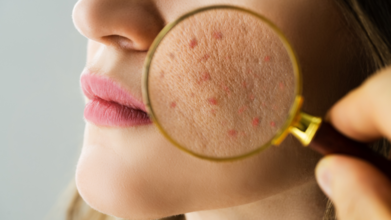- Health Conditions A-Z
- Health & Wellness
- Nutrition
- Fitness
- Health News
- Ayurveda
- Videos
- Medicine A-Z
- Parenting
- Web Stories
Not Everyone Taking Ozempic, Other GLP-1 Drugs Will Lose Weight, Experts Say

Ozempic and weight loss (Credit: Canva)
Not everyone who takes Ozempic is going to lose weight. Yes! However much shocking it may sound, researches have concluded that these drugs only work on 1 out of 5 people. Ozempic, like Wegrovy, Mounjaro and Zepbound, is a Glucagon-like peptide-1 (GLP-1 Receptor Agonist) drug that is primarily used to control blood sugar levels of Type 2 Diabetes patients. Weight loss is just a side-effect. However, with celebrities like Elon Musk, Kim Kardashian marketing it openly, it has gained immense popularity as a weight loss drug.
Clinical Trials Show Low Success Rate
In clinical trials, most participants taking Wegovy or Mounjaro to treat obesity lost an average of 15% to 22% of their body weight — up to 50 pounds or more in many cases. But roughly 10% to 15% of patients in those trials were "nonresponders" who lost less than 5% of their body weight.
These results are supported by obesity experts, who speaking to The Associated Press, said that nearly 20% patients may not respond well to these medications. They explained that these drugs do not work on one-size-fits-all principle. "It's all about explaining that different people have different responses," said Dr. Fatima Cody Stanford, an obesity expert at Massachusetts General Hospital.
GLP-1 Drugs Suppress Brain Chatter About Food
GLP-1 (a hormone secreted by your intestine) travels to your pancreas, prompting it to produce insulin. It also travels to the hypothalamus in your brain, which gives you the feeling of being full or satiated. These GLP-1 drugs like Ozempic drugs imitate this hormone, thereby, silencing the food chatter in the brain. Interestingly, for some people, this food chatter is really quiet ( people with low appetite); for others, it is an outburst (people who binge eat.) So with drugs like Ozempic, silencing this self-talk in the brain, people tend to lose their appetite and eventually weight.
There are multiple reasons that can prevent weight loss in a person consuming GLP-1 drugs. Medical conditions such as sleep apnea along with certain common medications, such as antidepressants, steroids and contraceptives can hamper the process of shedding extra pounds. Research shows that it is usually clear within weeks if they will work or not. Another major reason that can hamper weight loss are the side-effects of these drugs that can prompt a person to halt their prescription mid way.
What Are Side-Effects Of Consuming Ozempic?
As reiterated by doctors and health care experts, Ozempic is a drug that is tasked to help diabetic patients manage their blood sugar levels and weight. However, recent research has shown its effectiveness in mitigating various addictions like alcohol and drugs by inhibiting hormones. But what people ignore are its side effects, which include:
Nausea is a frequent side effect, especially when starting Ozempic or increasing the dose, and vomiting may occur along with nausea.
Diarrhoea and abdominal discomfort also show up in people using Ozempic, but they generally resolve as your body adjusts.
Ozempic can reduce appetite but may also lead to unintended weight loss or reduced food intake, causing discomfort for some people.
There are certain less common, but serious side effects also, like Pancreatitis, or inflammation of the pancreas.
This drug may also cause severe kidney issues, particularly if dehydration occurs from side effects like vomiting or diarrhoea.
How To Tell Your Skin Barrier Is Damaged? Step-By-Step Guide To Rebuilding Your Skin’s Defenses

Credits: Canva
That sudden tightness after washing your face, the redness that won’t calm down, or the stinging from a product you’ve used for years—those aren’t just random flare-ups. They’re signals. Quiet, persistent warnings from your skin barrier, your body’s frontline defense system.
Most people don’t even realize they’ve been slowly breaking it down. From over-cleansing to layering too many actives, modern skincare trends often leave the barrier confused, stripped, and vulnerable. But the good news? This protective layer is also incredibly responsive. When you treat it right, it bounces back—stronger, smoother, and more resilient than before.
“The skin barrier is your body’s natural shield, protecting against pollution, bacteria, and moisture loss,” says dermatologist Dr. Rupika Singh. “When it’s healthy, your skin looks and feels balanced. But when it’s damaged—often due to over-cleansing, too many actives, or skipping moisturizer—your skin can become dry, red, sensitive, or breakout-prone.”
What Is The Skin Barrier?
Your skin barrier lives in the stratum corneum, the outermost layer of your skin, and it functions much like a brick wall. The "bricks" are made up of dead skin cells, while the "mortar" that holds them together consists of lipids—specifically fatty acids, ceramides, and cholesterol. These lipids are essential for maintaining the skin’s structure and integrity. Inside the cells, Natural Moisturizing Factors (NMFs) act like water magnets, pulling in and retaining moisture to keep the skin hydrated. This highly organized system isn’t just for structure—it plays a crucial role in protection.
A healthy barrier keeps out irritants, allergens, bacteria, and pollution, while locking in hydration and essential nutrients. When functioning properly, your skin feels smooth, resilient, and balanced. But when this barrier is compromised, your skin quickly begins to send warning signs like dryness, tightness, redness, or increased sensitivity.
How to Know If Your Skin Barrier Is Damaged?
Here’s the tricky part, the first clue your barrier is under stress might be subtle—just a little dehydration. But if ignored, this can spiral into:
- Persistent dryness and flakiness
- Tightness after cleansing
- Redness or inflammation
- Breakouts or rough texture
- Increased sensitivity to your go-to products
“Your skin doesn’t need more products—just smarter ones,” says Dr. Singh. “A resilient barrier means fewer flare-ups, faster recovery, and that healthy, glowing texture we’re all after.”
What Damaged Skin Barrier Looks Like?
While environmental stressors like UV radiation, air pollution, and extreme weather are well-known culprits in weakening the skin barrier, the real damage often begins much closer to home—right at your bathroom sink. Daily skincare habits, when not done mindfully, can erode your skin’s natural defenses over time.
Over-exfoliating, for instance, strips away protective oils that are essential for barrier function. Using harsh cleansers can disrupt your skin’s natural pH, making it more vulnerable to irritants. Skipping moisturizer allows precious water to escape through transepidermal water loss, leaving your skin dry and more prone to damage. Overusing potent actives like retinol, AHAs, or BHAs may seem like a fast track to glowing skin, but they can actually compromise healthy cell turnover if not balanced properly. Even less obvious factors—like emotional stress or lack of sleep—can trigger inflammation that silently breaks down your barrier from within.
How Long Does It Take to Repair Your Skin Barrier?
A healthy skin cycle typically lasts about 28 days, so with proper care, most skin barrier issues can start to improve within 2 to 4 weeks. That said, even a few days of barrier-friendly habits can bring relief from tightness and irritation but consistency is key. Think of barrier repair like physical rehab—it requires patience, the right tools, and a slow, methodical approach.
Step-by-Step Guide To Building A Protective Skin Barrier
1. Simplify and Reset
Dr. Singh advises starting by scaling back:
“The first step toward healing? Simplify your routine. Switch to a gentle, hydrating cleanser and reduce exfoliation to once or twice a week. Give your skin a break from strong actives like retinol or acids until it feels calmer.”
Stick to essentials: a cleanser, moisturizer, and sunscreen. Once your skin stabilizes, you can slowly reintroduce actives.
2. Cleanse Gently
Use cleansers with a pH between 5.5 and 6.5, which match your skin’s natural acidity. Cream and oil-based formulas tend to be less disruptive than foam cleansers. Always wash with lukewarm water and pat dry instead of rubbing.
3. Hydrate and Moisturize in Layers
Hydration is about more than just applying moisturizer. Start with a hydrating serum containing hyaluronic acid or glycerin. While skin is still damp, apply a nourishing moisturizer with barrier-building ingredients like:
- Ceramides
- Niacinamide
- Panthenol
- Squalane
Dr. Singh emphasizes, “A nourishing moisturizer, applied twice a day, helps restore hydration and comfort.”
4. Don't Skip Sunscreen—Ever
Even mild sun exposure silently chips away at your skin’s barrier integrity. A broad-spectrum SPF 30 or higher helps prevent this, while antioxidants like vitamin C or E add an extra layer of defense against environmental stressors.
When your barrier is strong, your skin naturally fends off signs of premature aging, inflammation, and sensitivity. But when it’s weak?
- You’re more vulnerable to fine lines and wrinkles
- Inflammation triggers uneven skin tone
- Hydration loss makes skin look dull and tired
In other words, barrier health is the foundation of all good skincare. You can’t glow if your skin is busy trying to protect itself from further harm.
Most skin barrier issues are reversible. But you need to stay tuned in. If your skin suddenly feels off, flaky, or reacts to a product you’ve used for years, that’s your cue to reassess and recalibrate.
“So the next time your skin feels off, take it as a sign to slow down and tune in,” says Dr. Singh. “Often, what your skin really needs is less stress and more support—and that starts with protecting your barrier.”
Much like your gut or your immune system, your skin barrier is a living, breathing part of your health. Respect it, support it, and respond when it speaks up.
With a few thoughtful changes and a barrier-first mindset, you can transform not just how your skin looks, but how it behaves—resilient, calm, and confident in the face of whatever the world throws at it.
Dr. Rupika Singh is a Dermatologist and Founder at Akiya Aesthetics in India
15 Trillion Health Crisis Ahead: Plastic Is Everywhere, And It Is Making Us Sick

Credits: Canva
Plastic is everywhere. On mountaintops, in oceans, inside our bodies, and according to a new expert review published in The Lancet, it is silently wreaking havoc on human health from the womb to old age.
The review, first reported by The Guardian, calls the global surge in plastic production and pollution a full-blown “plastics crisis,” attributing at least $1.5 trillion a year in health-related damages to it.
The problem isn't just environmental, it’s deeply human.
The report warns of long-term consequences, ranging from infertility and birth defects to heart attacks and strokes. Vulnerable groups, especially infants and children, bear the brunt of the burden. “The impacts fall most heavily on vulnerable populations,” said Prof. Philip Landrigan, a paediatrician and epidemiologist at Boston College in the US, and the report’s lead author. “It is incumbent on us to act in response.”
A Rapidly Escalating Threat
Plastic production has skyrocketed, by more than 200 times since 1950, and if current trends continue, it's expected to almost triple again by 2060, exceeding one billion tonnes annually. While plastics have undeniable value in medicine and technology, the most explosive growth has been in single-use items: plastic bottles, food packaging, and disposable cutlery. These are the very things that crowd our landfills, rivers, and oceans.
Less than 10% of all plastic is recycled. The rest? It seeps into every corner of our ecosystem—from the deepest ocean trench to the peak of Mount Everest. In total, an estimated 8 billion tonnes of plastic waste now pollute the planet.
Harm at Every Stage: From Extraction to Disposal
What makes this crisis uniquely harmful is that plastics pose risks at every stage of their life cycle. They're derived almost entirely from fossil fuels: oil, gas, and coal, whose extraction and processing pollute air and water and fuel the climate crisis. Manufacturing plastic releases about 2 billion tonnes of CO₂ annually, more than Russia's total emissions.
Once produced, plastics expose people to thousands of chemicals, over 16,000, including flame retardants, fillers, and stabilizers. Many are toxic, and worryingly, many more haven’t even been fully studied. The lack of transparency from manufacturers makes it difficult to know exactly what we’re being exposed to.
As plastics degrade, they break down into micro- and nano-plastics, minuscule particles that can infiltrate nearly every organ of the human body. These particles have been detected in blood, placentas, breast milk, semen, and even brain tissue. Though long-term health effects are still being researched, early links suggest increased risks of strokes, heart attacks, and cancer.
A Crisis Hidden in Plain Sight
In many ways, plastic has become too familiar to question. Its pervasiveness masks its cost. While it's often treated as a cheap material, the true cost, once health impacts are accounted for, is staggering. The report notes that just three plastic chemicals (PBDE, BPA, and DEHP) are responsible for $1.5 trillion in damages annually across 38 countries.
The danger also extends to the environment in unexpected ways. Discarded plastics become breeding grounds for mosquitoes, potentially accelerating the spread of diseases like dengue and malaria.
A Turning Point: Can the World Act?
This latest report comes ahead of the sixth and likely final round of UN treaty negotiations aimed at creating a legally binding global agreement to address the plastics crisis. Over 100 countries support capping plastic production, while petrostates, particularly Saudi Arabia, and powerful industry lobbyists are pushing back, insisting that the focus should be on recycling, reported the Guardian.
But the report is clear: "The world cannot recycle its way out of the plastic pollution crisis."
Margaret Spring, a co-author and senior legal expert, said this analysis marks the beginning of a series of reports that will track plastic’s impact on human and planetary health. “These reports will offer decision-makers a robust and independent data source,” she said, “to inform the development of effective policies.”
As the world waits for action, the message from the medical and scientific community is becoming increasingly urgent: we cannot afford to ignore the cost of plastic any longer.
Does PCOS Makes IVF More Complicated? Fertility Experts Share Why Your Body Might Need A Different Plan

Credits: Health and me
If you're planning or experiencing the emotional and physical rollercoaster of IVF while living with Polycystic Ovary Syndrome (PCOS) you're not overthinking about the added complexity. While IVF is often painted as the silver bullet for infertility, women with PCOS quickly discover that one-size-fits-all protocols often fall short for them. The diagnosis of PCOS introduces a unique set of biological challenges that can’t be managed with standard IVF plans.
So, what makes IVF more complicated for people with PCOS? And how can treatments be tailored to fit these more complex bodies? We asked three top fertility specialists to break it down—and their answers underscore the importance of a highly personalized approach.
"Polycystic Ovary Syndrome (PCOS) is especially difficult to manage with IVF due to its combination of endocrine disturbance, insulin resistance, and a diffuse number of antral follicles," says Dr. Nishi Singh, Head of Fertility at Prime IVF.
According to Dr. Singh, women with PCOS often show an increased ovarian reserve, which may sound like a good thing. But in reality, it sets the stage for them to become hyper-responders—women who react too strongly to standard IVF stimulation, putting them at risk for Ovarian Hyperstimulation Syndrome (OHSS).
To mitigate these risks, Dr. Singh relies on individualized ovarian stimulation using low-dose therapy and GnRH antagonist protocols. “Oocyte quality is also an issue in PCOS. Although numerous eggs can be retrieved, they may have less developmental potential,” she notes. For this reason, the dosage must be carefully calculated to avoid overstimulation while still supporting optimal outcomes.
But it’s not just about the medication. “Successful IVF in PCOS goes beyond medical management,” Dr. Singh emphasizes. “Therapy would necessitate an approach that includes a lifestyle reaching a peak of metabolic health.”
That includes weight control, lifestyle modifications, insulin-sensitizing agents, and targeted supplements—all of which can improve ovulatory function and egg quality. Dr. Singh stresses that personalized care must be embedded in every stage of the IVF cycle, from initial stimulation to embryo freezing.
“If done with accuracy, IVF in PCOS patients is not a limitation but a promise,” she concludes. “The solution is individualized, regulatory, and based on individualistic knowledge of each patient's reproductive plan.”
Balancing High Ovarian Reserve, Low Egg Quality for Women with PCOS
Dr. Kaberi Banerjee, Founder and Medical Director of Advance Fertility & Gynecology Centre, agrees that PCOS requires a meticulous and integrated approach. "PCOS presents a special challenge in reproductive medicine since its impact on ovarian function is multidimensional," she says.
She explains that while high ovarian reserve is common in PCOS, as indicated by higher AMH and antral follicle counts, the quality of those eggs can be subpar. "Ovulation can be irregular or even cease to occur. Even mild stimulation can bring about an exaggerated ovarian response, increasing the risk of OHSS," she notes.
To counter this, Dr. Banerjee emphasizes pre-treatment optimization. Addressing insulin resistance, hormonal imbalances, and weight management before starting IVF can greatly improve results. She recommends lifestyle adjustments such as low glycemic diets, moderate physical activity, and supplements like inositols and CoQ10. Metformin also plays a central role in managing insulin resistance and improving ovarian response.
Her go-to strategy during IVF includes starting with low-dose gonadotropins, using GnRH antagonist protocols, and employing GnRH agonist triggers. “In high responders, we commonly follow a ‘freeze-all’ policy to prevent compromising endometrial receptivity,” she explains.
For younger PCOS patients, early preconception counseling and ovulation monitoring are vital. “First-line therapy such as letrozole, usually taken in combination with metformin, is very effective,” she says. And if that doesn’t work? IVF with a tailored approach is the next logical step.
“Achievement in treating PCOS-related infertility is a harmonious, evidence-based measure that benefits safety and long-term reproductive health,” Dr. Banerjee concludes.
What is The Role of Insulin, Hormones And Weight in IVF Success?
"The management of PCOS and IVF requires an extremely individualized approach," says Dr Shweta Mishra, Gynecologist and Obstetrician at Trulife Family Health Clinic in Ghaziabad, underscores the need for ultra-personalized care.
Dr. Mishra points out that PCOS affects nearly 70–80% of women with insulin resistance and presents with high antral follicle counts—often exceeding 24 per ovary. This makes conventional stimulation protocols not just ineffective but risky. “PCOS women may have a normal ovarian reserve but are susceptible to hyperstimulation,” she says. That means patient-specific regimens like low-dose stimulation and GnRH antagonist protocols are non-negotiable.
Egg quality is another critical piece of the puzzle. “Although numerous eggs can be retrieved from PCOS patients, the developmental potential of those eggs may be compromised,” she warns. Improving egg quality involves not just medication but also addressing hormonal balance through weight management, insulin sensitization, and supplements. “Enhancement of metabolism is critically important for success in IVF,” she adds.
Her message to younger women is clear: early diagnosis and a comprehensive plan can make all the difference. “PCOS need not be viewed as a disadvantage. It is an aspect that needs caution. Success rates significantly increase when IVF is treated with a personalized, specifically designed method.”
Does PCOS Make IVF More Complicated?
Yes, but it also opens the door to more personalized, effective treatments. As all three experts make clear, success with IVF and PCOS isn’t about pushing harder or using more medications. It’s about understanding the body’s unique biochemistry and crafting a treatment plan that respects its complexity.
IVF in the context of PCOS demands more than a protocol—it demands a philosophy of care rooted in customization, evidence-based medicine, and long-term reproductive health. And when that’s done right, PCOS isn’t a limitation. It’s a roadmap to smarter fertility care.
Before beginning any IVF treatment, consult a fertility specialist who understands the nuances of PCOS. The road may be more complex, but with the right plan, it can also lead to lasting success.
© 2024 Bennett, Coleman & Company Limited

